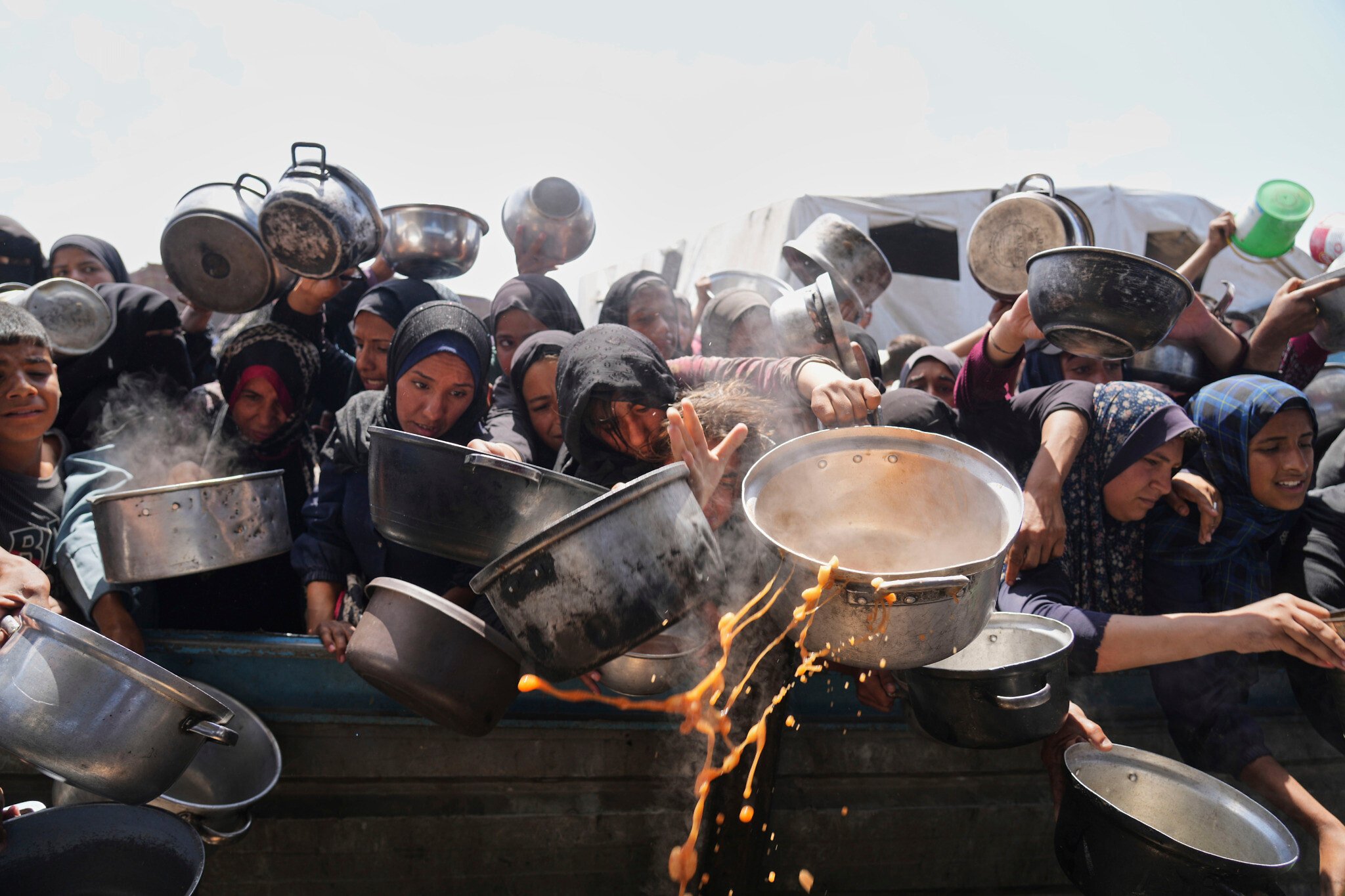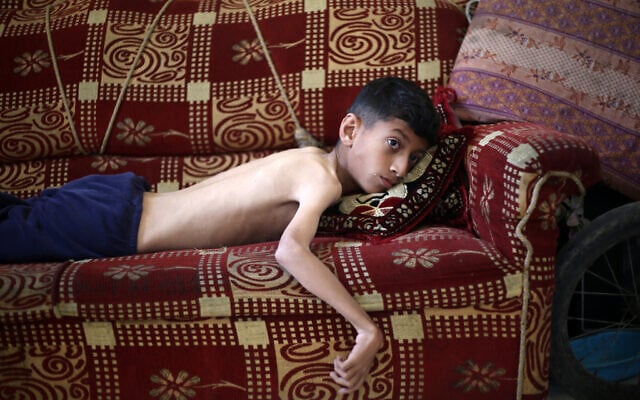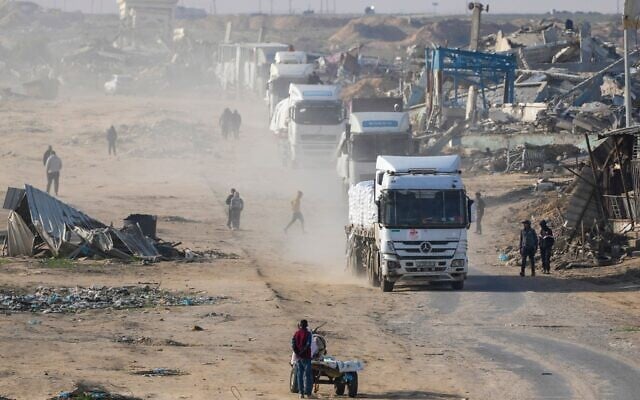



A global food-security analysis organization assessed on Monday that the overwhelming majority of Gaza’s population is at risk of famine in the coming five months due to Israel’s ongoing blockade preventing humanitarian aid from entering the territory since March 2.
The Integrated Food Security Phase Classification (IPC) organization said in a “Special Snapshot” briefing that “the Gaza Strip is still confronted with a critical risk of famine,” and that “the entire population is facing high levels of acute food insecurity, with half a million people [one in five] facing starvation.”
The IPC said the analysis was conducted remotely with data from “multiple sources,” and that the “evidence level” for the data was rated “medium.”
Israel said in response that “even according to the IPC’s own analysis,” there is currently no famine in Gaza, and noted that previous IPC projections about impending famine have “repeatedly failed to materialize.”
In March 2024, IPC predicted that a famine would break out in Gaza by July that year, but no such famine occurred, with food security improving in that period, leading the organization to acknowledge in June that there was indeed no famine.
Citing the report, UN World Food Programme’s Executive Director Cindy McCain said “families in Gaza are starving” and that it was “imperative” to get aid flowing again.
A calculation by the WFP regarding the amount of aid currently waiting at the Gaza border and how long it would feed Gazans appeared to indicate, however, that the food that entered Gaza between January 19 and March 2 should suffice for the population’s needs until the middle of July.
The IPC’s Special Snapshot, based on data available up to May 6, said its projection marked a “significant deterioration” from what it described as “the already dire situation” in the April 1 to May 10 period.
It projected that the entire territory of Gaza would fall into the Phase 4 “Emergency” category between May and September, with some 470,000 people falling into the Phase 5 “Catastrophe” famine category.
The document said that acute malnutrition in Gaza was assessed at phases 2 and 3 of its classification system (out of 5) between April 1 to May 10, but that would rise to Phase 4 “critical levels” in North Gaza and the Rafah Governorate from May to September.
According to estimates, however, very few civilians are left in the Rafah Governorate at present.
The snapshot also projected that there would be some 70,500 cases of acute malnutrition among children aged 6 to 59 months between April 2025 and March 2026, of which 20% would be severe acute malnutrition.
The IPC said that all 25 bakeries supported by the World Food Programme (WFP) in Gaza closed at the beginning of April due to a lack of supplies, and that food stocks for most of the 177 hot meal kitchens “are reportedly exhausted.”
“Latest data show many households resorting to extreme coping strategies,” the snapshot said. “A third reported collecting garbage to sell for food, while a quarter indicated that no valuable garbage remains.”
The organization added that in light of Israel’s declared intention to embark upon a renewed, broad military campaign in Gaza in the coming weeks and the “persistent inability” of humanitarian agencies to deliver essential goods and services, “there is a high risk that Famine [IPC Phase 5]” will occur in the territory between May and September.
World Health Organization Director-General Dr. Tedros Adhanom Ghebreyesus said the report showed that without “immediate access to food and essential supplies, the situation in Gaza will continue to deteriorate.
“We do not need to wait for a declaration of famine in Gaza to know that people are already starving, sick and dying, while food and medicines are minutes away across the border,” said Adhanom Ghebreyesus.
He claimed that since the aid blockade began on March 2, some 57 children have “reportedly died from the effects of malnutrition,” according to the Hamas-run health ministry in Gaza.
COGAT, a department of Israel’s Defense Ministry, blasted the IPC’s report, saying its previous projections of famine had not materialized and that it had “consistently” projected scenarios that were far worse than what occurred on the ground.
“The phrase ‘facing famine’ is misleading, as it refers to future scenarios projected by the IPC that have repeatedly failed to materialize since the start of the war and are based on assumptions that have been proven inaccurate and alarmist time and again,” COGAT stated.
It accused IPC of a “lack of transparency” with regards to the source of its data, and it said the IPC’s Special Snapshot failed to take into account “the massive volume of aid, especially food, that entered Gaza during the ceasefire.”
According to COGAT, over 25,000 trucks bearing humanitarian aid entered Gaza between January 19 and March 2, carrying some 448,000 tons of aid, 339,000 tons of which was food aid.
COGAT said the IPC relies on the UN for its data on aid to Gaza, and that UN agencies counted only a third of the actual aid that entered the territory during the ceasefire.
In response to the report, the WFP said on Monday that “more than 116,000 metric tons of food assistance – enough to feed one million people for up to four months — is already positioned in aid corridors.”
According to that metric, however, the 339,000 tons brought into Gaza during the ceasefire should suffice for Gaza’s population of 2.1 million people until the middle of July.
Israel’s Foreign Ministry said that IPC forecasts were “based on biased data — sourced from Hamas’s ‘Ministry of Health,’” which it said was “known for spreading propaganda,” and accused the terror group of stealing and hoarding aid that had entered the territory.
“Any conclusions drawn from such politically skewed and methodologically unsound data do not reflect the true humanitarian situation,” the ministry said. “Hamas exploits aid and keeps it in its warehouses to strengthen its control and rebuild its war machine.”



